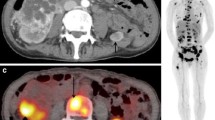Summary
In 1991, this prospectively designed study was started to assess the potentials of positron emission tomography with 18FDG in the diagnostic workup for the detection of lymph node metastases in testicular cancer, since there were no data available concerning this subject at this time. In 54 patients (27 patients with pure seminoma, 27 patients with non-seminomatous tumors) 18FDG-PET results were compared with the findings obtained with abdominal computed tomography, serum level of tumor markers (AFP, β -HCG), and the histopathological findings after primary or post-chemotherapy retroperitoneal lymph node dissection. In 21 patients with pure seminoma (clinical stage I according to the Lugano classification) 18FDG-PET results were identical with those of the abdominal computed tomography, so PET does not add relevant informations in this group of patients. In 7 patients presenting with non-seminomatous testicular cancer (stage I), PET was not able to detect the existing micrometastases in 4 patients. In 1/7 case PET examination showed a suspicious focal lesion, this lymph node had 2 micrometastases within inflammatory changes. In 1/7 patient 18FDG-PET definitely revealed metastatic lesions, while the CT scans where judged to be unobtrusive and tumor marker levels were within the normal range. In the 4 patients with pure seminomas stage II B and II C (N = 6), that have undergone retroperitoneal lymph node dissection following chemotherapy, 18FDG-PET correctly predicted absence of tumor in 3 out of these 4, and in 1/4 patient the benign nature of a persistent large tumor after two cycles of polychemotherapy was correctly identified wich eventually turned out to be a ganglioneuroma. This lesion falsely was classified as malignant tumor with abdominal computed tomography, and in 2/4 patients post-chemotherapy residual retroperitoneal lesions in the CT scans could not be assessed exactly whether or not malignant tumor was present. In 20 patients presenting with non-seminomatous testicular cancer (stage II and III) 18FDG-PET was able to demonstrate therapeutic effects of chemotherapy by showing decreasing tracer activity in those regions, that had hypermetabolic foci prior to chemotherapy. It became evident in testicular cancer that there is a single entity which is not characterized by increased glucose metabolism, the mature teratoma. In lesions detected by abdominal computed tomography which do not present increased 18FDG uptake, mature teratoma as well as scar/necrosis or rare other tumors with normal glucose metabolism can be supposed, but additional characteristics based on different 18FDG uptake were not observed. In 1/20 case post-chemotherapy PET scan detected a hypermetabolic lesion, which was suspicious for metastatic spread, but in the histopathological examination this lesion was identified as inflammatory tissue reaction. Based on the data reported here in 18FDG-PET cannot be considered a standard diagnostic tool in the staging examinations in testicular cancer. It is of clinical relevance in patients who present residual tumor after chemotherapy. In this situation 18FDG-PET is helpful in deciding whether or not a residual mass post-chemotherapy contains active tumor. 18FDG-PET can not replace retroperitoneal lymph node dissection for staging purposes.
Zusammenfassung
Das Ziel dieser 1991 begonnenen prospektiven Studie war, die Bedeutung der Positronenemissionstomographie mit 18FDG bei der Diagnostik der Lymphknotenmetastasen von Hodentumoren zu untersuchen, da zu diesem Zeitpunkt keine Daten bezüglich dieser Fragestellung zur Verfügung standen. Es wird über 54 Patienten berichtet (27 Patienten mit reinem Seminom, 27 Patienten mit nichtseminomatösen Tumoren), bei denen die 18FDG-PET-Resultate mit den Befunden der abdominellen Computertomographie, den Werten für die Tumormarker (AFP, β -HCG) sowie den histopathologischen Befunden nach primärer oder post-chemotherapeutischer retroperitonealer Lymphknotendissektion verglichen wurden. Bei reinen Seminomen im klinischen Stadium I nach der Lugano-Klassifikation (N = 21) waren die 18FDG-PET-Ergebnisse identisch mit denen der Computertomographie, so daß das Verfahren bei dieser Patientengruppe keine zusätzlichen Informationen bringt. Bei Patienten mit nichtseminomatösen Tumoren im Stadium I (N = 7) wurden bei 4 Patienten die vorliegenden Mikrometastasen durch die PET nicht detektiert, bei 1/7 Patienten hat die PET-Messung einen suspekten Herd ergeben, es fanden sich 2 Mikrometastasen in einem zusätzlich entzündlich veränderten Lymphknoten. In 1/7 Fall hat die 18FDG-PET eindeutig Metastasen detektiert (Tumormarker und Computertomogramm waren unauffällig). Bei den reinen Seminomen der Stadien II B und II C (N = 6) hat 18FDG-PET nach Chemotherapie das tumorfreie Lymphknotendissektat (pN0) von den 4 operierten Patienten 3 mal richtig präoperativ erkannt und im vierten Fall einer persistierenden großen Raumforderung die benigne Eigenschaft der Läsion (Ganglioneurom) identifiziert. Computertomographisch wurde dieser Befund als maligne (falsch-positiv) eingestuft, und bei 2/4 Patienten konnten computertomographisch residuale Lymphknoten nach Chemotherapie nicht eindeutig klassifiziert werden. Bei 20 Patienten mit nicht-seminomatösen Tumoren (Stadien II und III) konnte mit 18FDG-PET der Einfluß der Chemotherapie durch Aktivitätsminderung in prätherapeutisch hypermetabolen Herden (Normalisierung bis auf Hintergrundniveau) dargestellt werden. Es gibt eine einzige maligne Ausprägung der Hodentumoren, das reife Teratom, welche keine vermehrte 18FDG-Aufnahme zeigt. Bei computertomographisch erkennbaren, in der PET aber unauffällig dargestellten Läsionen sind differentialdiagnostisch reifes Teratom, Narbengewebe und/oder Nekrose bzw. seltene andere Tumorarten ohne gesteigerten Glukosestoffwechsel in Erwägung zu ziehen, aber eindeutige Unterschiede der Traceraufnahme zur weiteren Differenzierung wurden nicht beobachtet. In 1/20 Fall lag in der PET postchemotherapeutisch ein hypermetaboler Herd, fälschlich als maligne eingestuft, vor, der entsprechende Lymphknoten zeigte histopathologisch entzündliche Veränderungen. 18FDG-PET ist nicht als Routine-Untersuchungsverfahren bei Hodentumoren anzusehen. Die sinnvollste Anwendung ist bei der Bewertung von post-chemotherapeutischen Residualtumoren gegeben, um eine Entscheidungshilfe bei der Indikationsstellung zur RLA/weiteren Chemotherapie zu sein, jedoch ist die RLA zum Staging der Lymphknoten durch den Einsatz der 18FDG-PET nicht zu ersetzen.
Similar content being viewed by others
Author information
Authors and Affiliations
Rights and permissions
About this article
Cite this article
Müller-Mattheis, V., Reinhardt, M., Gerharz, C. et al. Positron-emission tomography with 18F-2-fluoro-2-deoxy-D-glucose (18FDG-PET) in the diagnosis of retroperitoneal lymph-node metastases from testicular tumors. Urologe 37, 609–620 (1998). https://doi.org/10.1007/s001200050223
Published:
Issue Date:
DOI: https://doi.org/10.1007/s001200050223




